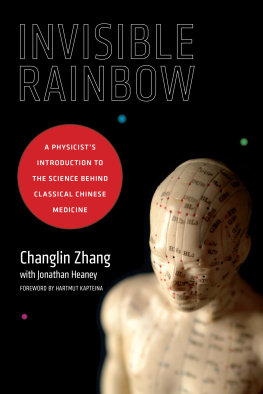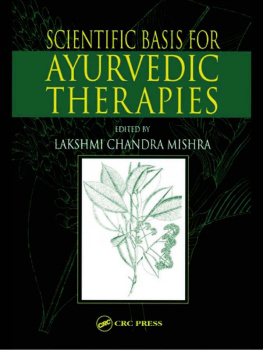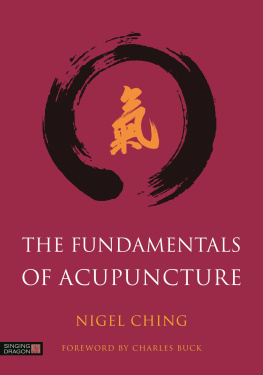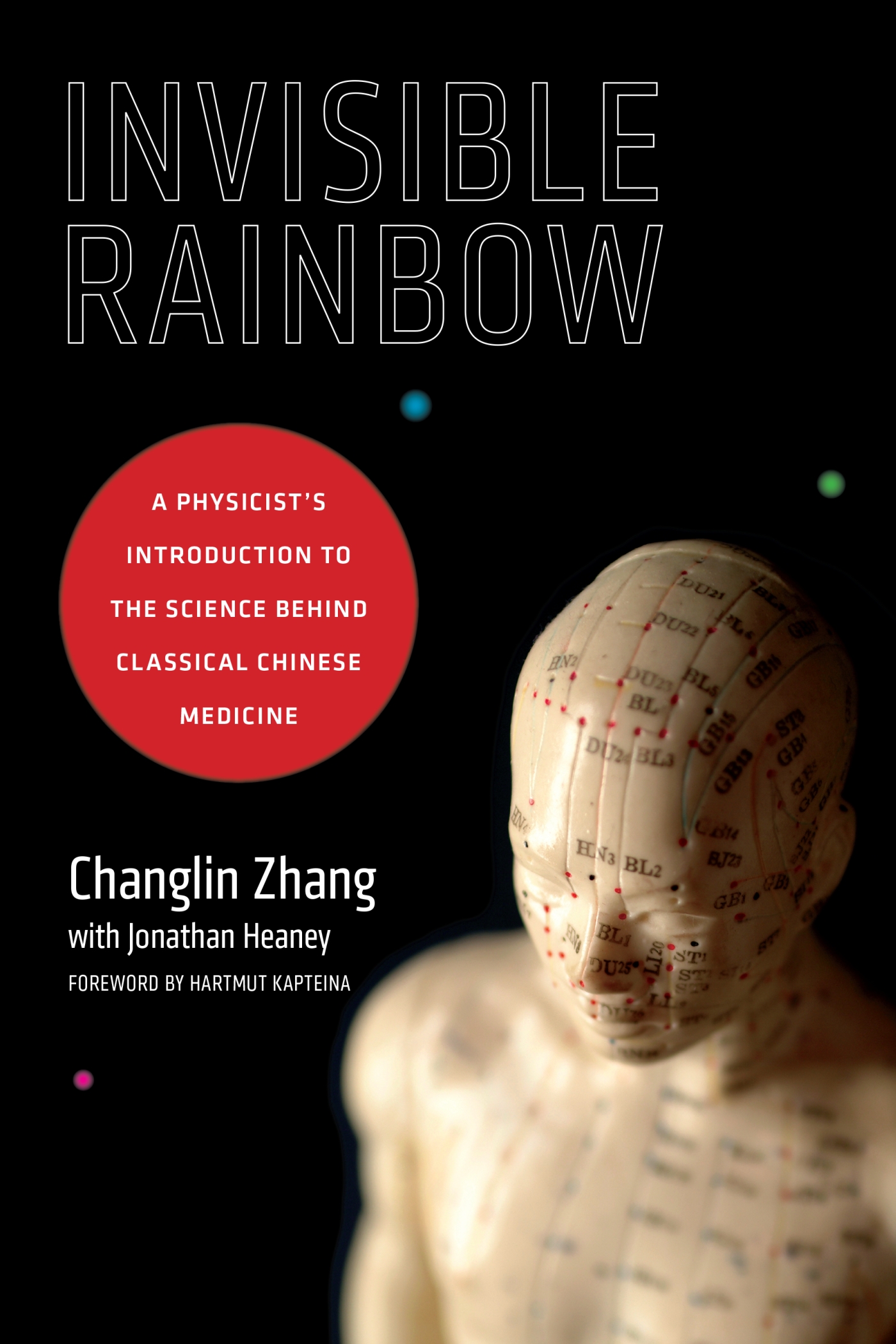HANS-JOACHIM HAHN, FOUNDER AND ORGANIZER OF PROFESSORENFORUM, AN ORGANIZATION OF GERMAN PROFESSORS
Many people will enjoy reading this book and benefit from it in various aspects.
The author, Professor Changlin Zhang, describes the acu-points and acu-meridians through a physics lens, with vivid language, proficient knowledge, and profound insight into modern physics.
INVISIBLE RAINBOW
A PHYSICISTS INTRODUCTION TO THE SCIENCE BEHIND CLASSICAL CHINESE MEDICINE
Changlin Zhang
with Jonathan Heaney
FOREWORD BY HARTMUT KAPTEINA

North Atlantic Books
Berkeley, California
Copyright 2016 by Changlin Zhang. All rights reserved. No portion of this book, except for brief review, may be reproduced, stored in a retrieval system, or transmitted in any form or by any meanselectronic, mechanical, photocopying, recording, or otherwisewithout the written permission of the publisher. For information contact North Atlantic Books.
Published by
North Atlantic Books
Berkeley, California
Cover photo: ritterdoron/iStock
Book design by Nicole Hayward
by United States Air Force Senior Airman Joshua Strang (public domain)
)
)
Invisible Rainbow: A Physicists Introduction to the Science behind Classical Chinese Medicine is sponsored and published by the Society for the Study of Native Arts and Sciences (dba North Atlantic Books), an educational nonprofit based in Berkeley, California, that collaborates with partners to develop cross-cultural perspectives, nurture holistic views of art, science, the humanities, and healing, and seed personal and global transformation by publishing work on the relationship of body, spirit, and nature.
North Atlantic Books publications are available through most bookstores. For further information, visit our website at www.northatlanticbooks.com or call 800-733-3000.
Library of Congress Cataloging-in-Publication Data
Zhang, Changlin, author. | Heaney, Jonathan, author.
Invisible rainbow : a physicists introduction to the science behind classical Chinese medicine / Changlin Zhang, with Jonathan Heaney.
LCCN 2015049047 (print) | LCCN 2016003076 (ebook) | ISBN 9781623170103 (print) ISBN 1623170109 (print) | ISBN 9781623170110 (ebook)
LCSH : Medicine, Chinese. | Acupuncture. | ElectromagnetismPhysiological effect.
LCC R 601 . Z 6852 2016 (print) | LCC R 601 (ebook) | DDC 610.951dc23
LC record available at http://lccn.loc.gov/2015049047
To the One who wrote the book with infinite pages and let me read a few of them.
ACKNOWLEDGMENTS
Max Reinhard in Germany, who sponsored the research project for more than fifteen years with incredible patience, tolerance, and confidence.
Hartmut Kapteina, professor of music and music therapy. My closest research partner and dear friend. He also wrote the beautiful foreword for this book.
Hans-Joachim Hahn, who is dedicated to rebuilding the soul and the spirit of universities in Europe and contributed greatly to getting the German version of this book published.
Jian-Ping Chu in Switzerland, Bisong Guo in Scotland, and Dan Jiang in Englanddoctors of Chinese medicine, who gave me a lot of help with discussions and encouragement.
Valerie Luff, a nurse who spent her career in missionary hospitals in Nepal, India, and Bangladesh. I met her when I was a visiting scholar in the University College London. She is my godmother and my real spiritual mother; particularly as I lost my own physical and spiritual mother in China when I was a teenager.
Ding-Zhong Li, professor of Chinese medicine in Beijing. A pioneer of modern scientific research into acupuncture. In 1996, he nominated me to be the leading scientist of the national project on meridian research.
Ke-Hsueh Li, one of a few theoretical physicists who truly, deeply understood the profound background of modern physics. My teacher during postgraduate studies at the Chinese Academy of Sciences, Beijing, from 1978 to 1981, and my research supervisor in Germany from 1991 to 1994. The first person to hear my idea of electromagnetic standing waves inside human bodies, many important experiments in this book were designed in accordance with his advice.
Elisabeth Reschat, Dietrich Stoeckl, Thomas Lastring for their work translating, refining, and improving the German version of this book as well as obtaining the copyright permissions for a number of figures in this book.
Hans-Juergen Stoeckmann, a professor at Marburg University, for kindly checking the statements from the viewpoint of physics in the German version.
Peter Weinberg, a professor at Hamburg University, gave many constructive suggestions for this book, and his doctoral student Christof Ziaja, who found a new statistical distribution with our coherence meter (or biometer) in their sleep lab.
Xiang-Yang Zhao in Germany, a brilliant young scholar and physicist who assisted the Chinese translation by providing many critical and constructive opinions.
Zhong-Shen Liu, my gifted, old and dear friend at the Heilongjiang University of Traditional Chinese Medicine, for further refining the Chinese version.
My beloved family, my wife, Xinger (Angela), and our son, Zhiliang (Albert). Our son was the first person tested with music measurement and, like his mother, always supports me with love, hope, and persistence.
My students, Zhi-Hao Zheng, Min Zhang, Hong-Zhen He, Yi-Bin Pan, Hai-Ou Wang, Bo-Lin Xu, Yuan-Dong Zhou, Li-Jun Meng, and many others in China, who did so much important work along with my former assistant Da-Lin Li, who helped to edit and publish Current Development of Biophysics at Hangzhou University Press in China in 1996.
Jonathan Heaney, who spent countless hours improving and rewriting the entire English manuscript sentence by sentence and word by word. Jonathan would like to thank his wife, Mei Ling Chang, for her constant support, encouragement, and feedback as well as Cindy Colson and Jillian Heaney for their advice and feedback.
Actually, this list is endless; it is impossible to acknowledge all of those who helped me in any book with limited pages.
CONTENTS
In his book Nada Brahma: The World Is Sound, Joachim-Ernst Berendt, the famous jazz researcher and cross-thinker in musical science, says that Japanese Zen masters asked their students to do the following meditation exercise: If you delete purpose and sound, what do you hear? Yes, the ear was actually capable of hearing the vibrations of elementary parts, because the cilia, the antennae through which the hearing cells receive information, have a radius the same size as a molecule.







